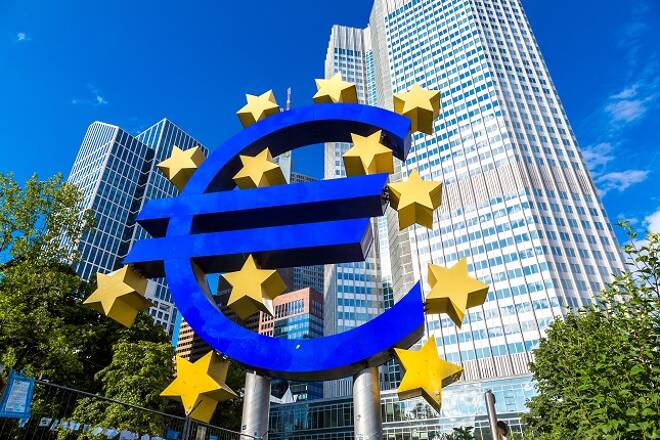Advertisement
Advertisement
The Euro Tumbles Through Support Following Dovish ECB Tone
By:
The EUR/USD moved lower on Thursday following the ECB’s meeting, where the central bank focused on weakening sentiment. Draghi seemed to shrug off the
The EUR/USD moved lower on Thursday following the ECB’s meeting, where the central bank focused on weakening sentiment. Draghi seemed to shrug off the weakness in the sentiment surveys but described the current level of monetary stimulus sufficient to handle the current softness.
Technicals
The EUR/USD broke down on Thursday as the tone of the ECB meeting was dovish. The exchange rate pierced through the lows made in March at 1.2154 and are poised to test the 200-day moving average at 1.2004. Resistance is seen near former support at 1.21.54 and then an upward sloping trend line that was the former breakdown level at 1.2245. Momentum is negative as the MACD (moving average convergence divergence) is printing in the red with a downward sloping trajectory which points to lower prices. The fast stochastic tumbled reflecting accelerating negative momentum but the current reading of 5, is well below the oversold trigger level of 20 and could foreshadow a correction. Once the fast stochastic generated a crossover buy signal, a rebound is likely.
The ECB Focused on Current Sentiment
ECB didn’t discuss monetary policy, instead Draghi said officials discussed the situation in individual economies, amid the broad based slowdown in confidence indicators. Draghi went into some details on the overall mood of the discussion, highlighting that the slowdown is broad based across countries and sectors but overall suggesting that the sense at the ECB is that data has to be interpreted with caution. The message is that the central bank favors a steady hand policy at the moment.
Draghi shrugs off weakness in survey indicators, but said that there is ample degree of monetary accommodation remains necessary. The ECB remains on course to end QE by the end of the year, but not quite ready yet to commit to such a step. Draghi said the moderation in growth indicated by recent indicators, may reflect a pull back from the very strong rates at the end of the year, but also special factors and overall growth remains robust and solid.
German consumer confidence dips slightly
German GfK consumer confidence fell back to a still very strong 10.8 with the projected May reading, as expected. The full breakdown for the April reading, which was confirmed at 10.9, showed a sharp dip in economic confidence, as well as a slight decline in income expectations, despite the strong wage deals in Germany so far. At the same time though the willingness to buy improved and the willingness to save declined, so still good news for the consumption outlook, especially as the labor market remains very tight and wages are set to rise this year.
Spanish labor market Are Decelerating
Spanish labor market has weak start to 2018. Spanish employment dropped -0.65% quarter over quarter in the first quarter of the year, although compared to the first quarter 2017, employment was still up 2.36%. The unemployment rate rose to 16.7% from 16.5%, although as a silver lining, the youth unemployment rate fell back to a still very high 36.3%.
The Riksbank left policy unchanged
The Riksbank left policy unchanged and pushed out tightening guidance, tweaking the wording to suggest that a rate rise would happened “towards the end of the year” after saying in the previous statement in February that a rate rise would happen in the “second half of the year.” The repo rate was left at -0.50%, as had been widely anticipated and where it has been since 2015. More subdued than expected underlying inflation coupled with house price declines have offset strong economic growth and a tightening labor market.
The UK’s April CBI distributive trades survey met expectations
The UK’s April CBI distributive trades survey met expectations with a reading of -2 for headline realized sales, unchanged from the month prior. The CBI reported that sales remained below average for the time of year, while orders placed on suppliers fell slightly, although are expected to pick up in the month ahead. The retail sector has been suffering over the last year, on net, following a sustained period of inflation-adjusted declines in average household incomes, overcapacity and tech-driven structural change.
Durable Goods Order Rose
U.S. Advance durable orders rose 2.6% in March after the 3.5% bounce in February which was revised from 3.1%. Transportation orders increased 7.6% after February’s 8.9% jump which was revised from 7.1%. Excluding transportation, orders were flat from the prior 0.9% gain which was revised from 1.2%. Nondefense capital goods orders excluding aircraft were fell 0.1% versus the 0.9% prior gain which was revised from 1.8%. March shipments were up 0.3% from the 0.7% February gain. Nondefense capital goods shipments ex-aircraft dropped 0.7% from 1.0% which was revised from 1.4%. Inventories edged up 0.1% after the prior 0.4% gain.
About the Author
David Beckerauthor
David Becker focuses his attention on various consulting and portfolio management activities at Fortuity LLC, where he currently provides oversight for a multimillion-dollar portfolio consisting of commodities, debt, equities, real estate, and more.
Did you find this article useful?
Latest news and analysis
Advertisement
